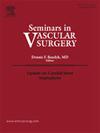Best practice offloading treatments for diabetic foot ulcer healing, remission, and better plans for the healing-remission transition
IF 2.4
3区 医学
Q1 PERIPHERAL VASCULAR DISEASE
引用次数: 0
Abstract
Diabetes-related foot disease is arguably the world's least known major health problem and causes a disease burden larger than most well-known diseases, such as stroke and breast cancer. This burden is driven by people developing more severe stages of foot disease, such as foot ulcers and infections, and with that worsening quality of life. To reduce this burden, we need treatments that prevent more severe stages of foot disease and improve quality of life. Best practice offloading treatments have been found to be arguably the most effective existing treatments to heal and prevent diabetes-related foot ulcers and infections, but can worsen quality of life. Furthermore, high re-ulceration rates still occur with best practice offloading treatments after healing. This may be because of the gap in guideline recommendations on the transition from ulcer healing to ulcer remission when it comes to offloading treatments. In this paper, we review why we need offloading treatments and what are the best offloading treatments recommended by the latest international guidelines for healing and remission. Further, we propose plans for future best practice offloading treatments for the transition from healing-to-remission to help reduce re-ulceration rates and improve longer-term ulcer remission. These plans could be the catalyst for better transitioning patients from first ulcer presentation through healing and into long-term remission, and in turn delivering better quality of life, and lower diabetes-related foot disease burdens on patients, nations, and the globe in future.
最佳实践卸载治疗的糖尿病足溃疡愈合,缓解和更好的计划,为愈合缓解过渡
糖尿病相关足病可以说是世界上最不为人所知的重大健康问题,其造成的疾病负担比大多数众所周知的疾病(如中风和乳腺癌)都要大。造成这种负担的原因是,人们出现了更严重的足部疾病阶段,如足部溃疡和感染,生活质量也随之恶化。为了减轻这一负担,我们需要预防更严重阶段的足病和改善生活质量的治疗方法。最佳实践卸载治疗被认为是现有治疗和预防糖尿病相关足部溃疡和感染的最有效的方法,但可能会使生活质量恶化。此外,高再溃疡率仍然发生在愈合后的最佳做法卸载治疗。这可能是因为当涉及到卸载治疗时,从溃疡愈合过渡到溃疡缓解的指南建议存在差距。在本文中,我们回顾了为什么我们需要卸载治疗,以及最新的国际愈合和缓解指南推荐的最佳卸载治疗是什么。此外,我们提出了从愈合到缓解过渡的未来最佳实践卸载治疗计划,以帮助减少再溃疡率并改善长期溃疡缓解。这些计划可以成为催化剂,使患者从首次溃疡表现更好地过渡到愈合并进入长期缓解,进而提供更好的生活质量,并在未来降低患者、国家和全球的糖尿病相关足病负担。
本文章由计算机程序翻译,如有差异,请以英文原文为准。
求助全文
约1分钟内获得全文
求助全文
来源期刊
CiteScore
3.50
自引率
4.00%
发文量
54
审稿时长
50 days
期刊介绍:
Each issue of Seminars in Vascular Surgery examines the latest thinking on a particular clinical problem and features new diagnostic and operative techniques. The journal allows practitioners to expand their capabilities and to keep pace with the most rapidly evolving areas of surgery.

 求助内容:
求助内容: 应助结果提醒方式:
应助结果提醒方式:


